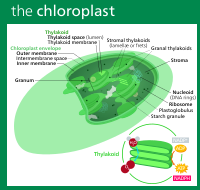
Photo from wikipedia
Rubisco is an enzyme found in photosynthetic organisms, which catalyse the first step of biomass accumulation: the carbon dioxide incorporation to ribulose-1,5-bisphosphate. Because of Rubisco’s complicated, multimeric structure and a… Click to show full abstract
Rubisco is an enzyme found in photosynthetic organisms, which catalyse the first step of biomass accumulation: the carbon dioxide incorporation to ribulose-1,5-bisphosphate. Because of Rubisco’s complicated, multimeric structure and a presence of many labile structural elements the enzyme cannot assemble to its native quaternary structure by itself. This is why the folding and assembly process of Rubisco requires the strictly organized operation of a number of auxiliary factors. Chaperone proteins take part in folding of holoenzyme subunits, subsequently they mediate in subunit oligomerisation, and in some cases chaperone proteins direct subunits to their cellular destination such as the carboxysomes or the pyrenoid. In addition to their canonical function of mediating Rubisco assembly, these chaperones are involved in additional processes such as quality control of the biosynthetic process, and regulation of organelle physiology and cellular compartments.
Journal Title: Postepy biochemii
Year Published: 2022
Link to full text (if available)
Share on Social Media: Sign Up to like & get
recommendations!